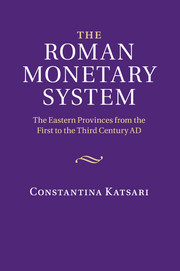Book contents
- Frontmatter
- Contents
- List of charts
- Acknowledgements
- List of abbreviations
- Framing the Roman Monetary System: An Introduction
- 1 Statistics and numismatics
- 2 Planning the financial policy of the Roman state
- 3 Trimetallism and bimetallic laws
- 4 The application of the Quantity Theory of Money to third-century economics
- 5 Roman monetary integration
- 6 Micro-economies
- 7 Metallism vs. chartalism
- Appendix 1 The inscription of Mylasa
- Appendix 2 Excavations finds, coin hoards and museums
- References
- Index
Framing the Roman Monetary System: An Introduction
Published online by Cambridge University Press: 01 March 2011
- Frontmatter
- Contents
- List of charts
- Acknowledgements
- List of abbreviations
- Framing the Roman Monetary System: An Introduction
- 1 Statistics and numismatics
- 2 Planning the financial policy of the Roman state
- 3 Trimetallism and bimetallic laws
- 4 The application of the Quantity Theory of Money to third-century economics
- 5 Roman monetary integration
- 6 Micro-economies
- 7 Metallism vs. chartalism
- Appendix 1 The inscription of Mylasa
- Appendix 2 Excavations finds, coin hoards and museums
- References
- Index
Summary
The main goal of this book is to properly frame and analyse the operation of the Roman monetary system from the first to the third centuries AD in the eastern provinces. The comprehensive study of a system such as the Roman may also give us the opportunity, in the future, to compare it with the mediaeval and the early modern ones, since they all share a range of similar characteristics. Here I may restrict myself to the use of comparative points with selected case studies (from Europe, North America and China) but I am convinced that fully comparative studies could and should emerge. I also hope that such a volume will enhance our understanding of the nature of ancient money and that, at the same time, it will prove that the Roman monetary economy was based on a sophisticated pre-industrial, pre-capitalist, pre-modern system. By this, I mean a monetary system that regulated the economic agents, controlled the money supply and identified the specific medium of transactions. Behind this system, at least in the case of the Roman empire, hid the central government, which guaranteed the value of money and the exchange of currencies, while it determined its monetary policies according to the needs of the treasury and the demands of the markets.
This study will be restricted to the geographical area to the Eastern Mediterranean provinces. These provinces represent a mosaic of different coinages, all of which were unified under the Roman political rule.
- Type
- Chapter
- Information
- The Roman Monetary SystemThe Eastern Provinces from the First to the Third Century AD, pp. 1 - 8Publisher: Cambridge University PressPrint publication year: 2011



